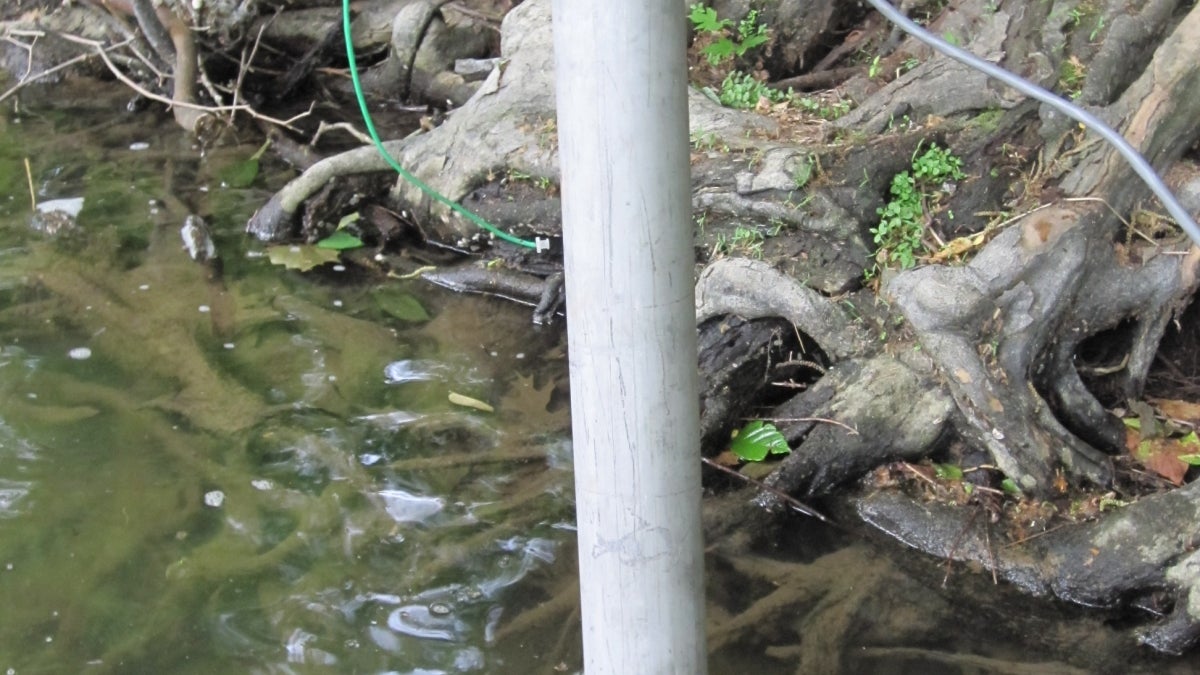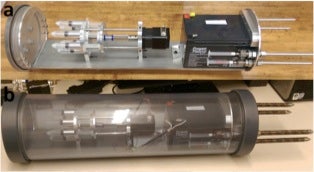Innovative ASU-created device traces chemicals affecting human, environmental health

An earlier version of the in situ sampling device. The lower portion of the tubular instrument is submerged in sediment while the upper portion is exposed to pore water. The IS2B tool can register contaminants at very low detection limits for a broad spectrum of contaminants, ranging from fully water-soluble to highly sorptive and hydrophobic
Every hour, a multitude of chemicals complete their use life in homes, agricultural fields and industries and flood into the environment. The ultimate fate of these compounds is often poorly understood, as are the risks they may pose to humans and the ecosystems that are essential for our survival as a species.
In a new study, a multi-disciplinary, multi-institutional team of researchers headed by Rolf Halden, director of the Center for Environmental Security at Arizona State University’s Biodesign Institute, tracks the course of a family of widely used pesticides known as fiproles. These halogenated chemicals have been identified as an emerging contaminant, recently linked to the worldwide die-off of pollinating insects, particularly honeybees.
To properly assess the levels of fiprole contamination in the environment, Halden’s team invented a new device, constructed at the Biodesign Institute. Known as the IS2B, the tool is a kind of mobile laboratory or pod for performing precision analysis on sampled water and sediment. The technology offers improved accuracy of measurement compared with existing methods as well as greater versatility and cost-effectiveness.
“Health risks from pollution are dependent not necessarily on the absolute quantity of toxins present but rather on what fraction of the total pollutant mass is accessible for uptake by living organisms. The patent-pending IS2B device is designed to tell apart and quantify these two important quantities,” said Halden.
Halden is joined by professor Nancy Denslow and collaborators from the Department of Physiological Sciences and Center for Environmental and Human Toxicology, University of Florida, Gainesville. The research appears in the advanced online issue of the Nature Publishing Group journal Scientific Reports.
Hazards unseen
Human and aquatic lifeforms face increasing threats from chemical contamination. The United States Environmental Protection Agency (USEPA) estimates that 10 percent of the sediments located in domestic lakes, rivers and harbors are contaminated with potentially harmful chemicals. It is therefore essential to carry out environmental sampling to properly evaluate the degree of hazard and design remediation strategies, where needed.
Soils, sediments and water resources can bind chemicals to varying degrees, making them available to microbes, plants, wildlife and humans. Yet, few of the chemicals in daily use have been properly assessed for safety. Researchers like Halden and Denslow hope to measure the capacity of potentially hazardous chemicals to be absorbed by living organisms, a quantity known as their bioavailability.
Certain chemicals are known to evade degradation, persisting in the environment for decades. Among these tenacious pollutants are hydrophobic compounds, which are highly durable and resistant to breakdown. Such chemicals can be tricky to measure and track, due to their ability to permanently sequester in pore spaces between sedimentary particles. Often, they are not degraded during the normal process of wastewater treatment.
Measurement of bulk water and sedimentary pore water can provide something like an environmental blood test, informing researchers about the presence and relative risk of chemicals of concern in samples. Accurate environmental sampling is often challenging, however. Many contaminants occur in low concentrations in the environment, yet may seriously affect living organisms due to uptake and long-term storage, a process termed bioaccumulation. Current methods of sample collection, preparation, and analysis may under- or overestimate the actual chemical mass available to cause harm in exposed animals and humans.

Newer version of the device, known as the
IS2B. The tool is a kind of mobile laboratory
or pod for performing precision analysis on
sampled water and sediment.
Sifting for chemicals
The in situ sampling/bioavailability tool (IS2B) is a specialized instrument providing simultaneous sampling of contaminant levels in bulk and sedimentary pore water at previously unattainable detection limits.
The IS2B contains integrated multi-channel pumps, which simultaneously draw surface water and sediment pore water into the active sampling device. Then, the water is pushed at high and low flow rates through an array of filters and adsorption media. When in use, the lower half of the tubular instrument is buried in sediment, while the upper portion is exposed to pore water.
The water samples can be stored in the device or readily expelled into the bulk water. Due to unlimited access to pore and bulk water during use, the IS2B tool can register contaminants at very low detection limits for a broad spectrum of contaminants, ranging from fully water-soluble to highly sorptive and hydrophobic.
The device allows for direct determination of bioavailability and ultimately seeks to replace or minimize the use and exposure of animals for toxicity assessment. Samples may be collected over arbitrary time periods and the method can evaluate both dissolved and particulate contaminants in both free-flowing surface water and more stagnant pore water in the sediment.
A suspect emerges
Fipronil, the focus of the new study, is a broad-spectrum halogenated pesticide that has recently been banned in the European Union for most agricultural uses. Fipronil’s use in the United States, however, remains widespread. The chemical is the active ingredient in many pesticide formulations used in both urban and agricultural settings, for such applications as termite treatment, seed treatments, and to protect turf from pest infestation.
Scientists have been alarmed and perplexed by the rapid collapse of honeybee populations. Serious efforts to identify the culprit have produced conflicting data. Honeybees are vital participants in the complex web of life, pollinating roughly 80 percent of all flowering plants. One third of all agricultural production depends directly on bee pollination. Mite infestations, viral pathogens and the impact of pesticides all have been implicated in honeybee colony collapse disorder, as the epidemic is known.
The new study sampled water and sediment extracted from three locations in a wetland in the Southwestern United States. The wetland examined receives outfall from a waste treatment plant, adjacent to agricultural fields. The results of IS2B in situ monitoring of fiprole concentrations were compared with those obtained by more cumbersome and time-demanding conventional benchtop laboratory analysis.
Results showed close agreement between IS2B data and the current gold standard of measurement techniques. Further, the study was able to identify the chemical fipronil-desulfinyl occurring at one location in trace amounts that evaded detection by conventional sampling, highlighting the benefits of continuous in situ analysis for capturing transient fluxes of chemicals at levels much lower than previously attainable. Use of the IS2B also reduces the chances of sample contamination from handling in the laboratory facility, as the majority of sample processing steps are conducted in place at the sampling site.
Another important benefit of the device is its ability to collect samples continuously for extended periods of time, from days to several weeks. This makes possible the detection of short-term fluctuations in chemical loading, such as illegal dumping of process streams into surface waters. As such, information gathered with the IS2B is vital to environmental compliance reporting, modeling and risk assessment for biota and humans.
More Science and technology

Indigenous geneticists build unprecedented research community at ASU
When Krystal Tsosie (Diné) was an undergraduate at Arizona State University, there were no Indigenous faculty she could look to…

Pioneering professor of cultural evolution pens essays for leading academic journals
When Robert Boyd wrote his 1985 book “Culture and the Evolutionary Process,” cultural evolution was not considered a true…

Lucy's lasting legacy: Donald Johanson reflects on the discovery of a lifetime
Fifty years ago, in the dusty hills of Hadar, Ethiopia, a young paleoanthropologist, Donald Johanson, discovered what would…